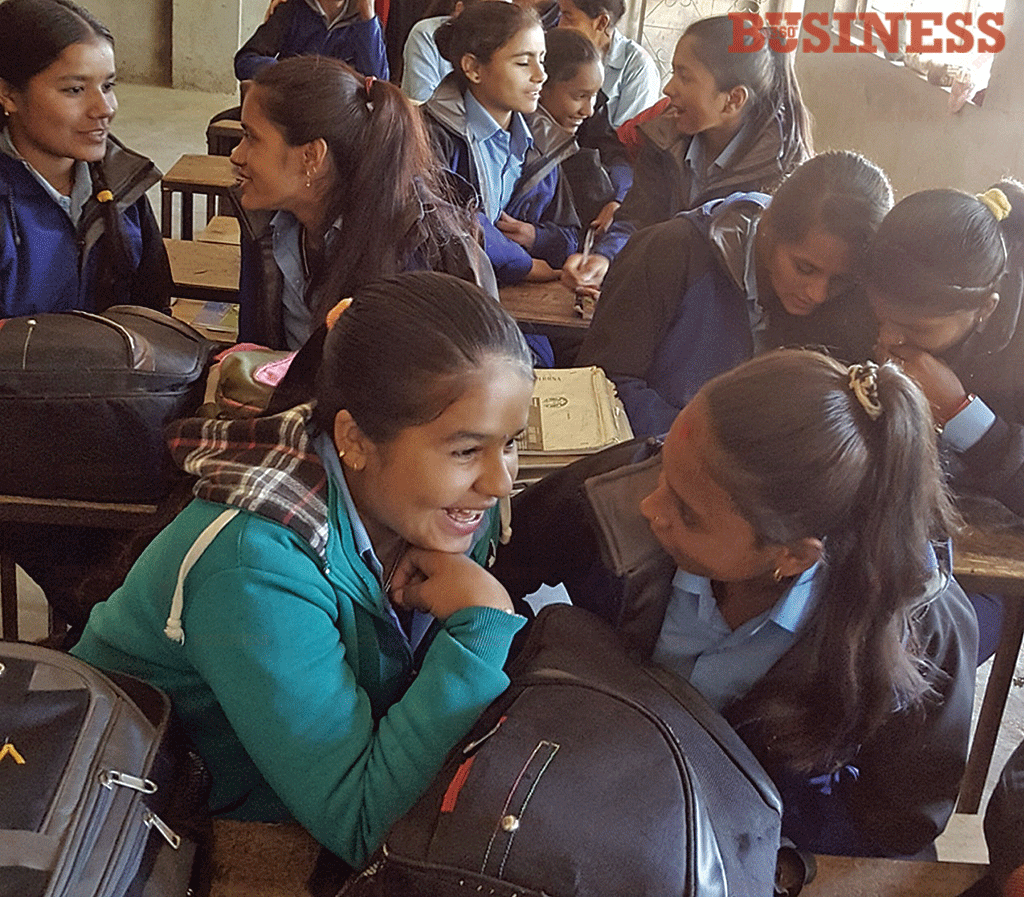
Building local trust, forging partnerships with government, and ensuring sustainability are the major elements intrinsic of different NGOs and INGOs working in educational projects in the country. And it requires more than just fundraising to create sustainable futures.
Text: Ankita Jain
BlinkNow
In 2007, Maggie Doyne and Top Malla co-founded BlinkNow Foundation to serve the needs of Nepal’s children. Doyne wanted to do more than just pay for tuition fees of the underprivileged children. She came to Nepal as a young student and what she experienced trekking through the country impacted the direction of her life forever. With USD 5000 from her savings while babysitting children back home, she purchased land in Surkhet. The local Nepali community helped her establish the home’s foundation. She also had supporters from her hometown in Mendham, New Jersey, USA. The Foundation fulfills its mission by providing financial support and management oversight to the Children’s Home and Kopila Valley School in Surkhet, Nepal. In addition to the home and school, there is a Health Clinic and a Women’s Center for the Kopila Valley community.
Established in Surkhet, the Kopila Valley School provides free, quality education to more than 400 students. Not all the children are orphans, but they are all from disadvantaged or impoverished backgrounds. In addition to education, the Foundation also provides ‘zero interest loans’ to some of the students to help them reach their goals. These students can then choose to continue their studies with vocational training or undergraduate studies. “Our hope is that our students will become the future farmers, doctors, engineers, teachers, business owners, and architects that will uplift their communities and bring positive development to the country,” says Maggie Doyne, Co-Founder and the driving force of BlinkNow.

In 2007, Maggie Doyne and Top Malla co-founded BlinkNow Foundation to serve the needs of Nepal’s children. She came to Nepal as a young student and what she experienced trekking through the country impacted the direction of her life forever.
Each year BlinkNow creates a budget for its five main program areas, and operational costs that together combine their overall fundraising goal for the year. Any donation that is made to the organisation with a restriction is 100% designated to that area. Doyne explains, “For example, a small or large gift to our children’s home can only be funneled to the children’s home program. Any donation that is made without a designation allows us to use it to our greatest needs. This allows us the flexibility to ensure all our programs are funded.” For any fund that comes in, it has to come through their sponsor program named Roots. It enables the supporters to sign up for a recurring monthly donation. “Our supporter base is mainly from individual people and families. Through Roots, members give $5 up to $1,000 a month to support our children,” she states. This strategy supports the foundation all year long. Besides, it participates in big philanthropic days like #GivingTuesday which is their single largest fundraising day of the year. This day alone can support up to 10% of their annual budget. Talking about Nepali donors, she shares, “We have a growing donor base in Nepal. Hotel owners, small business owners, community members, and people who have heard our story, have decided to support directly within Nepal.”
Alike other NGOs, BlinkNow also applies for grants throughout the year; participate in paid speaking opportunities at conferences; and engages families who are looking to make a big impact in Nepal through large philanthropic giving. They ensure their projects do not get hampered in the absence of funding pouring from patrons and grants, Doyne has a prompt reply. “We built a green school and this way we are cutting expenses one by one.” The Kopila School features solar power, rainwater harvesting, organic farming, and rammed earth buildings that stay cool in the summer and warm in the winter. Keeping energy costs low, the foundation is moving towards sustainability.
Snow Yak Foundation

Snow Yak was formally established by Binod Shahi and a group of self-motivated youth as a non-government organisation in 2014. Before the Foundation came into picture, Shahi was volunteering as a teacher in Dolpa since 2004. Today, the main objective of Snow Yak is to provide quality education in Dolpa. The foundation supports 20 schools in the region.
Snow Yak Foundation runs two major campaigns- Children for Children and Fellowship. Children for Children focuses on collecting stationery and books from around 35 schools in Kathmandu and circulates them in Dolpa. Under Fellowship campaign, every year a number of determined youths join the Foundation in the journey to educate children of Dolpa. “The fellows endure geographical adversity and many other challenges and dedicate 6-8 months of their life to the children of Dolpa,” says Binod Shahi, Founder of Snow Yak Foundation. This year they received 70 application, out of which 12 individuals will be selected. The remuneration paid to every fellow for their 6-8 months contribution is Rs 70,000. “We view this cost as not for the fellow but for the education of around 60 children,” explains Shahi. There are 1240 students in total. The overall cost of running one school in lower Dolpa and upper Dolpa is around Rs 3 lakhs and Rs 4 lakhs respectively.
Out of 20 schools listed under Snow Yak, 12 are fully taken care by the Foundation and the rest are supported via stationery. Next year, they are reducing the number of schools from 12 to 10. “Locals are also taking initiatives and we are running short on funds,” shares Shahi.
Snow Yak accepts funds from Nepali nationals only. “When we are approached by international donors, we route them to other organisations which accept foreign funds and are doing good work in Dolpa,” he states.
To run all the activities smoothly, Snow Yak requires Rs 60 lakhs. And the annual collection averages Rs 25 lakhs or lower and they must survive on it. “To cope, we cut down on administration and other costs which can be controlled. At times we aren’t capable of paying the fellows as well. We also go for barter where possible,” he shares. The foundation does not have big donors. “Every year, Citizen Bank contributes Rs one lakh as part of their CSR, Shikshya Foundation contributes Rs three lakhs annually and many individuals and families comprise our donor list,” he states. Besides, Summit Air sponsors flight tickets from Nepalgunj to Dolpa of their fellows. Further, there is an additional cost of Rs 30,000 to reach lower Dolpa and Rs 50,000 to reach upper Dolpa. This cost is cut down to half due to their goodwill and collaborations. “We have earned people over the years,” he smiles.
Moving towards sustainability, Snow Yak Foundation is working to establish a self-sustained Dolpa promoting education and entrepreneurship cohesively. “In the future, we plan to transform our project in Dolpa from solely funded Nepali school to locally funded school,” he claims. In this model, parents trade locally produced goods as fees for the education of their children. The products are sold in Kathmandu and the income raised is reinvested into the project. Apart from this, they are also promoting tourism by organising treks in the region. “All the arrangements for the treks will be made by local people and includes guides and porters from the same region,” he explains.
Teach For Nepal

The fund raising policy of TFN is such that it receives 70% funds from Nepali donors and the rest 30% from the foreign grants.
Teach For Nepal (TFN) is a non-profit organisation that is part of the Teach For All network. Under their fellowship program, they recruit college graduates and working professionals to serve as full-time teachers in public schools for two years. Teach For Nepal aims to end the problem of educational inequity in the country and provide education excellence to all children. Established in 2013, the organisation works with 65 schools and has 138 fellows currently taking their mission forward.
Starting form Lalitpur district, Teach for Nepal has spread to seven districts in seven years. The two year fellowship program benefits not only the children but also the fellows. TFN offers an attractive incentive package for selected fellows. The package includes leadership training opportunities, financial incentives, internship and the possibility of job placements as well as opportunities for scholarships and graduate studies (for a Master’s degree) in prestigious colleges and universities in Nepal and abroad. “Their two-year contribution is a complete investment towards their career,” says Swastika Shrestha, Co-founder and CEO, Teach For Nepal.
Partnering with local government, TFN is drawing attention towards the quality of education in public schools. “The local government puts in some money and works mutually,” Shrestha briefs. Not only inside the school premises but the fellows also work towards the upliftment of the community. Citing one such case, she recalls, “To end discrimination between lower and upper castes, one of our fellows introduced the concept of homestay in the community and it brought about a massive change.”
Talking about funds, last year the annual report of the organisation showed total funds received at Rs 6 crores 99 lakhs approximately and the total expenses was around Rs 7 crores 3 lakhs. “The difference is covered by cutting on the expenses,” she says. The fund raising policy of TFN is such that it receives 70% funds from Nepali donors and the rest 30% from the foreign grants. The organisation has 250-300 individual donors, people who donate every day, corporate houses, banks, etc. “HH Bajaj has been supporting us since day one. Surya Nepal is another big contributor,” she adds. Besides, TFN staff contribute 1% of their salary for the cause. People also donate during special occasions like birthdays, anniversary, etc. “There was a couple who collected Rs 10 lakhs and donated it to us rather than spending it on their wedding,” she informs. The organisation also campaigns during Dashain and other festivals and accepts donation through their website, eSewa and more.
TFN majorly channelises the fund in three fields: recruitment, training and alumni support. When the training, stipend and other investment on a fellow is calculated, it turns out that a fellow costs Rs 7.5 lakhs per year. Similarly, through a fellow, the organisation is spending Rs 400 per student per year. “It’s less than what a cup of coffee costs you,” she says. On the other hand, alumni support covers the contribution of past fellows towards the community.
Addressing the sustainability plan of the organisation, Shrestha believes their contribution towards a better future and a better community is supported by numerous people. “Our sustainability plan is that we strive on people’s compassion. As long as people believe in generosity, we will sustain,” she claims.
Srijanalaya

Srijanalaya contributes towards lesson plans and the organisation is working to document a resource manual for teachers. It will include teaching methods used by different teachers and how they can use it as a reference in the future.
Srijanalaya is a non-profit, non-government organisation established to create safe spaces of learning through the arts. They are a growing community of artists and educators in the country who offer creative mediums as an alternative approach to rote-learning and static textbooks. They engage children and their communities in visual, performing, and language arts workshops, exhibitions, and performances during which they consciously incorporate diverse indigenous and local art forms and materials as much as possible. Established in 2014, the organisation is currently working majorly in Sindhupalchowk. Altogether Srijanalaya works with 34 schools from grade one to five.
Srijanalaya as an organisation works on two major programs- ArtWorks! Sangai Khelaun and Art-in-school. Artworks! Sangai Khelaun is carried out in public schools outside the Kathmandu Valley. An essential component of the program is to ensure that the content, expressive mediums, and language reflect the students’ lived realities. “We encourage schools to build their own local curriculum and incorporate creative and storytelling mediums from the community, such as indigenous dance and music,” says Sharareh Bajracharya, Founder, Srijanalaya. Over the years, the use of these mediums in school has helped bridge the void between children’s homes and school. This program began in the aftermath of the April 2015 earthquake and is supported by Shikshya Foundation Nepal.
On the other hand, Art-in-school is a program that focuses on how to bring the creative arts into the formal education system in Nepal. The organisation has designed a month-long practical training package where they integrate the arts as a medium of instruction into a subject area such as math, science, social studies or language arts. “Through teacher training program, we are trying to make our mission self-sustainable,” claims Bajracharya.
Srijanalaya contributes towards lesson plans and the organisation is working to document a resource manual for teachers. It will include teaching methods used by different teachers and how they can use it as a reference in the future. As an organisation, they are investing on available resources rather than introducing a new element in the system.
It is always three years collaboration with any school Srijanalaya is working with. The team believes it is after those three years that they can actually evaluate the progress. “The three year term has been carefully planned to make the program progressive and it is upto the school to continue further,” says Niranjan Kunwar, a member of Srijanalaya and an independent educational consultant and writer.
To raise funds, Srijanalaya works for different projects; the Children’s Book project under Asia Foundation being one of them. “This is their second year of commitment,” she informs. Besides, a trust fund of Bajracharya’s family also helps. “It is a small fund but we have been relying on it for the past few years now. We have limited fund,” she shares. The organisation plans to expand its programs and they realise that more funds are required. They are finding means to collaborate with like-minded people and bring about change. “We are a team of artists ourselves and lack the mindset required for raising fund,” she says. She emphasises that administration cost is the most difficult part of fund raising. “No one wants to pay this cost. People don’t realise that no organisation can sustain for long without this.”
Srijanalaya also does annual fundraising programs. “This is our second year. And we are hoping to raise sufficient funds,” she explains. Similarly, Daya Foundation has committed to support one school for three years. The cost of conducting program in one school per year is Rs 4 lakhs which includes every need,” she states. Can Help Nepal is another like-minded organisation working with Srijanalaya. The plan is to conduct programs in five schools of Suryabinayak in the next three years.
Shikshya Foundation Nepal

Shikshya Foundation Nepal was established in 2011 by New York based Fashion Designer Prabal Gurung with his siblings Pravesh Gurung and Kumudini Gurung Shrestha, and friends Rati Shah, Rupali Golchha and Riva Thapa. The executive board comprises of Rati Shah, Kumudini Gurung Shrestha, Rupali Golchha and Riva Thapa. They collectively decide on the work scope and implement the programs voluntarily with zero overheads. All donations go to implement specific projects. The Foundation works to provide holistic growth to children, addressing their financial, social and emotional needs. SFN has partnered with six foundations and supports individual scholarships to many students from different parts of the country.
Starting with girl education, Shikshya Foundation Nepal first partnered with Early Childhood Development Center in 2011. SFN supports the education of all 23 girls at Butterfly Home run by ECDC. “SFN seeks to oversee and facilitate the education of children in need from primary school through secondary school and higher education,” says Kumudini Gurung Shrestha. SFN provides counseling to every student they support and ensures that their financial and emotional needs are catered to.
SFN identifies partner organisation and support the various projects they run. “We support Artworks! Sangai Khelaun program of Srijanalaya in 29 schools of Sindhupalchowk,” shares Riva Thapa. Similarly, SFN started supporting Snow Yak Foundation even before it was officially registered. SFN looks into long term partnership from every partner foundation. “For many of our partners we have been a consistent supporter,” informs Rupali Golchha.
Earlier the foundation was supported by a few business houses in the country but later, the fundraising aspect was shifted to the New York team and the implementation of the programs is carried out from the capital. In terms of transparency, SFN makes sure that every partner foundation shares a report of how the fund is being channelised.




-1761806697.jpg)
-1758006240.jpg)
-1752225714.jpg)